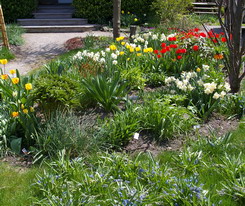

|
What happened to spring. In our part of the world we seem to have gone straight into summer. The pleasantly cool days of early May that make it possible to spend long hours in the garden have been replaced by summer-like heat. It makes it more difficult to move and transplant anything and the lack of rain is not helping. The Tulips are coming up quickly but the blooms seem to fry up in just a few days. Ahh! Complaining about the weather; our eternal pastime. The front gardens with all of the bulbs in bloom are really quite gorgeous. Managed to get a few of the new perennials from the holding bed to more permanent locations. A few varieties of Phlox that I ripped out of a friends garden last fall were put there to see what they would do. Most have started growing quite happily and have now found places in the front beds where there was little colour after the daylilies finished. I’m anticipating that these colourful phlox can brighten up the drab days of August. We’ll see what happens. 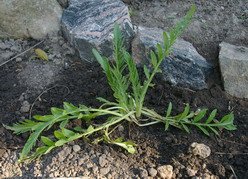 I also had some Oriental Poppies. I bought a package of poppy seeds that had a mix of new colours in it. In one of my few misguided attempts to be organized, I grew them in the holding/propagation bed until I could see what colour they were, the better to choose a permanent planting location for them. The propagation bed is in a rather shady location to keep the hot sun away from tender cuttings etc but after two seasons there, it is becoming apparent that more sun is needed to make these Poppies actually bloom. So they got moved to the main beds without any of that planning of the colour palette that I had attempted.
I also had some Oriental Poppies. I bought a package of poppy seeds that had a mix of new colours in it. In one of my few misguided attempts to be organized, I grew them in the holding/propagation bed until I could see what colour they were, the better to choose a permanent planting location for them. The propagation bed is in a rather shady location to keep the hot sun away from tender cuttings etc but after two seasons there, it is becoming apparent that more sun is needed to make these Poppies actually bloom. So they got moved to the main beds without any of that planning of the colour palette that I had attempted. We did manage to get a good number of the early vegetables planted. The lettuce, some of the onions and various Bok Choi and Rapini transplants are standing up and doing well. As always they get a shot of liquid starter fertilizer, 10 52 10 when they get moved to the garden; as does almost anything else that I move or transplant. 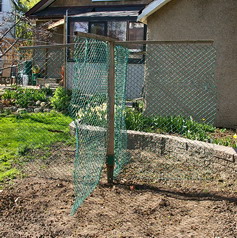
One of the best developments in vegetables since I started gardening was the introduction of the edible podded peas. The original Sugar Snap is a delight. There have been several subsequent introductions to try and make it easier to manage but I still like the original variety. Its apparent problem is the rather lengthy growth. I see this as a great advantage because it fits in with my Vertical Vegetables theme so well. If I can get the same number of pods from 10 tall plants that it would take 20 shorter plants to produce then that is wonderful news. Vertical space is something we all have lots of in our gardens. The pea trellis that I have developed allows to me make good use of that vertical space and I like picking peas 8' / 250cm off the ground. There might be $ 15 worth of material in this pea fence and I have been using it for almost 10 years. Not a bad investment. I didn’t buy the lengths of chain link fence; somebody is always throwing the stuff out and one man’s trash is another man’s treasure. 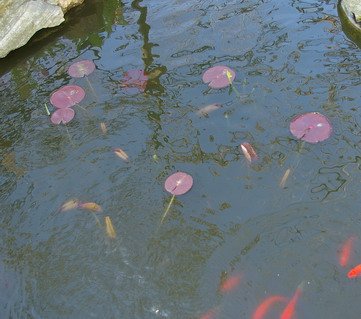 The pond gorp remains in place in the middle pond and the water lily that has escaped into it, is sending nice early leaves to the surface, all over the pond. Cleaning it out is looking less likely especially since my attempts to find the leak in the river system have been monumentally unsuccessful. Despite the very dry weather there appears to be lots of moisture in the soil beside the middle river. Im trying to avoid noticing that signal, because ripping that up, to find the leak, will not be a pretty job.
The pond gorp remains in place in the middle pond and the water lily that has escaped into it, is sending nice early leaves to the surface, all over the pond. Cleaning it out is looking less likely especially since my attempts to find the leak in the river system have been monumentally unsuccessful. Despite the very dry weather there appears to be lots of moisture in the soil beside the middle river. Im trying to avoid noticing that signal, because ripping that up, to find the leak, will not be a pretty job. Questions I offered the readers of Dallying In The Dirt, the opportunity to ask questions and you took me up on that offer. You can just hit the reply button on this newsletter. MS Kelly asks: I am so glad you have decided to start this part of your newsletter for the readers. Here goes - I have mulched my butterfly bush (year old plant which flowered a little last year) last winter with leaves and then covered it with burlap - it came through the winter just fine, now has lots of green leaves around the bottom part - I wonder if I should cut it back now or not as I believe it won't bloom til later in the summer. I would also like to know how soon and how short to trim the old parts of my Rose of Sharon bush for this season, I did not trim it before last winter - I covered it with burlap and leaves. (it is about 2-3 yr. old)Thanks for your answer. 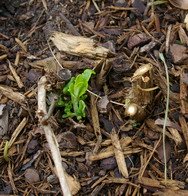 Ken responds.
Ken responds. Butterfly Bush, Buddleia spp grows reasonably well in Zones 5/6 but its above ground parts rarely overwinter. The burlap wrap was probably poor use of your time. Dying to the ground, works out just fine because it flowers on the current season’s growth. Just prune it back very close to the ground, wherever it is showing new growth and it will grow quite rapidly and bloom in mid-summer. The picture on the right is all I can find of my Buddleia on May 10. 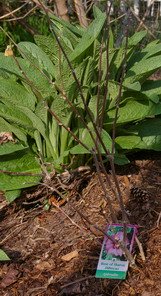 Rose of Sharon, Hibiscus syriacus should probably be called the “patience tree”. It reminds us each spring that Mother Nature sets the timetable not we humble gardeners.
Rose of Sharon, Hibiscus syriacus should probably be called the “patience tree”. It reminds us each spring that Mother Nature sets the timetable not we humble gardeners.Wait! Wait! Wait! This is probably the last shrub or tree to break out into leaf in my garden. I don’t start to even think about considering it dead until the middle of June. Because it starts so late, it does not grow that much each year and as a result, it should require very little, if any, pruning. If it has a branch that still appears dead long after the others have leafed out then I would remove that branch or any others that are growing at weird angles. The “dead” stick in the left hand picture, (nice Comfrey in the background) is my year old Rose of Sharon on 10 May and it will probably look like that for another few weeks. We all are over anxious to get our gardens growing in the spring. Be a lazy gardener and don’t declare something dead and rip it out until well into the season. It just may surprise you. 111 Trent St. Whitby L1N 1L9 |
